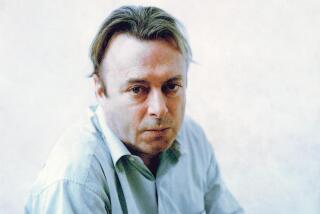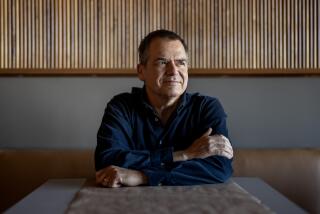Critic’s Notebook: Under the influence of Hemingway
- Share via
For much of the 1980s, beginning when I was in college, I used to read a Hemingway book a year. The point was not self-improvement but rather a kind of exploration: What was it, exactly, about his writing that I’d missed? I had read “The Sun Also Rises” in high school and had admired its spare portrayal of 1920s expatriate life. But I’d also thought of it as more than a little stilted, even melodramatic in its way.
Of all the great American between-the-wars writers — “the three kings,” as Richard Ford referred to Hemingway, Faulkner and Fitzgerald in a 1983 essay, although I’d also include John Dos Passos in their company — the one who most spoke to me was Faulkner, with his flowing sea of language, his sense of the past, of history, as a living thing. Next to him, Hemingway seemed flat, two-dimensional. Where was his appeal? If only I kept reading, I might find out.
I worked through my share of the novels: “A Farewell to Arms,” “For Whom the Bell Tolls.” I was compelled, in places, yet still felt distant. Then, on a train from New York to Chicago, I discovered the 1925 collection “In Our Time,” Hemingway’s American debut. The 15 stories here include some of his most iconic: “Big Two-Hearted River,” “The Three-Day Blow,” “The Doctor and the Doctor’s Wife.” These works helped rewire American short fiction with their bluntness, their lack of affect, their insistence that we read between the lines.
“If a writer of prose knows enough about what he is writing about,” Hemingway observed in “Death in the Afternoon,” his 1932 study of bullfighting, “he may omit things that he knows and the reader, if the writer is writing truly enough, will have a feeling of those things as strongly as though the writer had stated them.” That’s a revolutionary idea, with its recognition that writing and reading are a collaboration. And yet, for all that “In Our Time” offers, the book stands out for me by remaining — along with “The Old Man and the Sea” and some of the nonfiction — one of the few by Hemingway that I truly love.
Hemingway shot himself to death on July 2, 1961, 50 years ago this weekend, but questions about his legacy resonate. In part, this has to do with the contradictory nature of his character: innovator and reactionary, self-mythologizer and cliché, purveyor of both a new way of seeing and some of the most garish stereotypes of masculinity, with his fixations on big-game hunting, booze and war.
Although he wrote almost to the end (and he’s published posthumously at a rate rivaled only by L. Ron Hubbard and Jack Kerouac), he had produced most of his important work by 1940, when “For Whom the Bell Tolls” appeared. He was a personality — along with Fitzgerald and some others, I’d suggest, an early example of the writer as celebrity, as famous for who he was as for what he wrote — and yet, half a century after his death, he is misunderstood, if we think of him at all.
The world has changed: How many readers, in the aftermath of Vietnam or the last slogging decade in Iraq and Afghanistan, still consider war a noble gesture, a crucible? How many, in an era when we blog or tweet with equal weight our deepest secrets and least significant interactions, have any use for Hemingway’s stylized reserve? Even back when I was actively reading him, he seemed a writer of another time. Twenty-five years later, that moment too feels archaic, like so much ancient history, leaving me to wonder what, if anything, Hemingway can still mean.
I raised this issue recently with a number of writer friends on Facebook, and what I got back was illuminating. Some made jokes, while others mentioned the experiences of their children. (Apparently, Hemingway is still assigned in high school, if less often than he used to be.) One friend referred to her own high school struggles with “For Whom the Bell Tolls” — after which, she noted, she never read Hemingway again. Most interesting, though, were the half-dozen or so responses that addressed the work directly, not as a matter of content so much as one of style. Even those who didn’t consider Hemingway a favorite cited his stripped-down approach, his intent to reinvent the language, his commitment not to tell.
I think of “Cat in the Rain,” perhaps my favorite of his stories, which in three concise pages portrays a marriage on the cusp of unraveling, without ever making that overt. The young American wife at the center of the narrative is dissatisfied but only aware of it as an undertone. As her husband reads, uninterested, she stares out the window of their Italian hotel room, then tries to rescue a cat caught in the rain. The story unfolds over the course of only a few minutes, but these minutes are intensely weighted, especially when the wife goes downstairs and runs into the hotel-keeper, an older man who is everything her husband is not. “The wife liked him,” Hemingway writes. “She liked the deadly serious way he received any complaints. She liked his dignity. She liked the way he wanted to serve her. She liked the way he felt about being a hotel-keeper. She liked his old, heavy face and big hands.”
You can read that passage in a variety of ways: as a deft character description or as an example of Hemingway’s aesthetic in action, with the repetition of “She liked” working to remind us of the story as a written artifact. Yet most important is how the spareness sets up the emotion, by forcing us to inhabit these sentences for ourselves.
What is Hemingway asking us to do, after all, if not to compare this man, in the wife’s eyes, to her husband, who does not and will never match up? He doesn’t need to say it; we can see it, and its implications for the future of their relationship. If, as he once wrote, “all stories, if continued far enough, end in death,” he is revealing to us here a way station, freighted with both past and future, a catalyst, an epiphany. Its simplicity is what makes it beautiful, although paradoxically this may explain why I remain conflicted about his longer works. In a novel it is harder to sustain this kind of focus, and for me, Hemingway can lose his sharpness when he has to deal with plot. Just look at “To Have and Have Not,” which is a mess of a book, or “Across the River and Into the Trees.”
So what does this mean for his relevance? That’s an obligatory question, given the anniversary of his death, but it is the wrong question to ask. Instead, let’s think about his influence, which remains an influence of style.
Without Hemingway, could we have Raymond Carver, Denis Johnson, Russell Banks or Tobias Wolff? Could we have Albert Camus’ “The Stranger,” modeled (stylistically, anyway) on both him and James M. Cain? Could we have the work of Norman Mailer, his closest literary descendent, or, for that matter, Hunter S. Thompson, who admired his stance as l’homme engagé? Perhaps his truest value lies in what he has passed down.
“I think you should learn about writing from everybody who has ever written that has anything to teach you,” Hemingway wrote to Fitzgerald in 1925. It has been decades since I gave up trying to reconcile my own ambivalence about his writing, but if he has a legacy, this may be where it resides.
More to Read
Sign up for our Book Club newsletter
Get the latest news, events and more from the Los Angeles Times Book Club, and help us get L.A. reading and talking.
You may occasionally receive promotional content from the Los Angeles Times.








